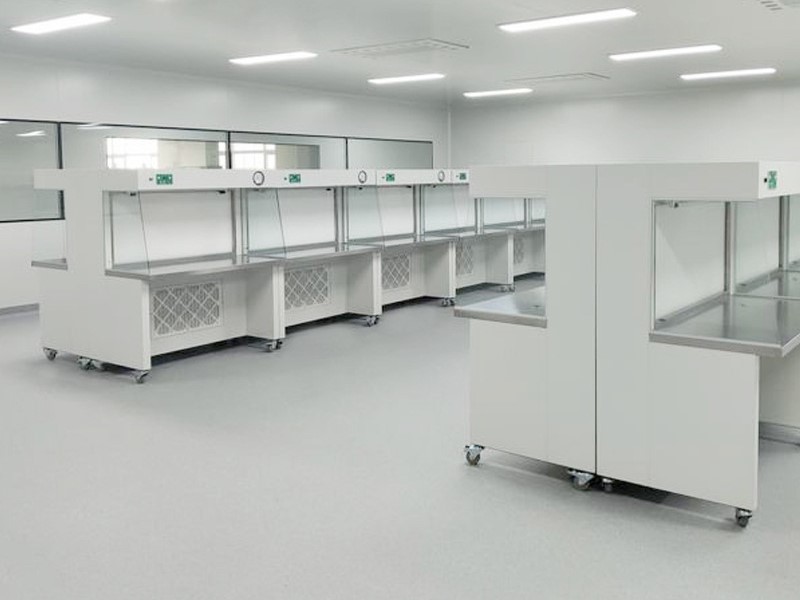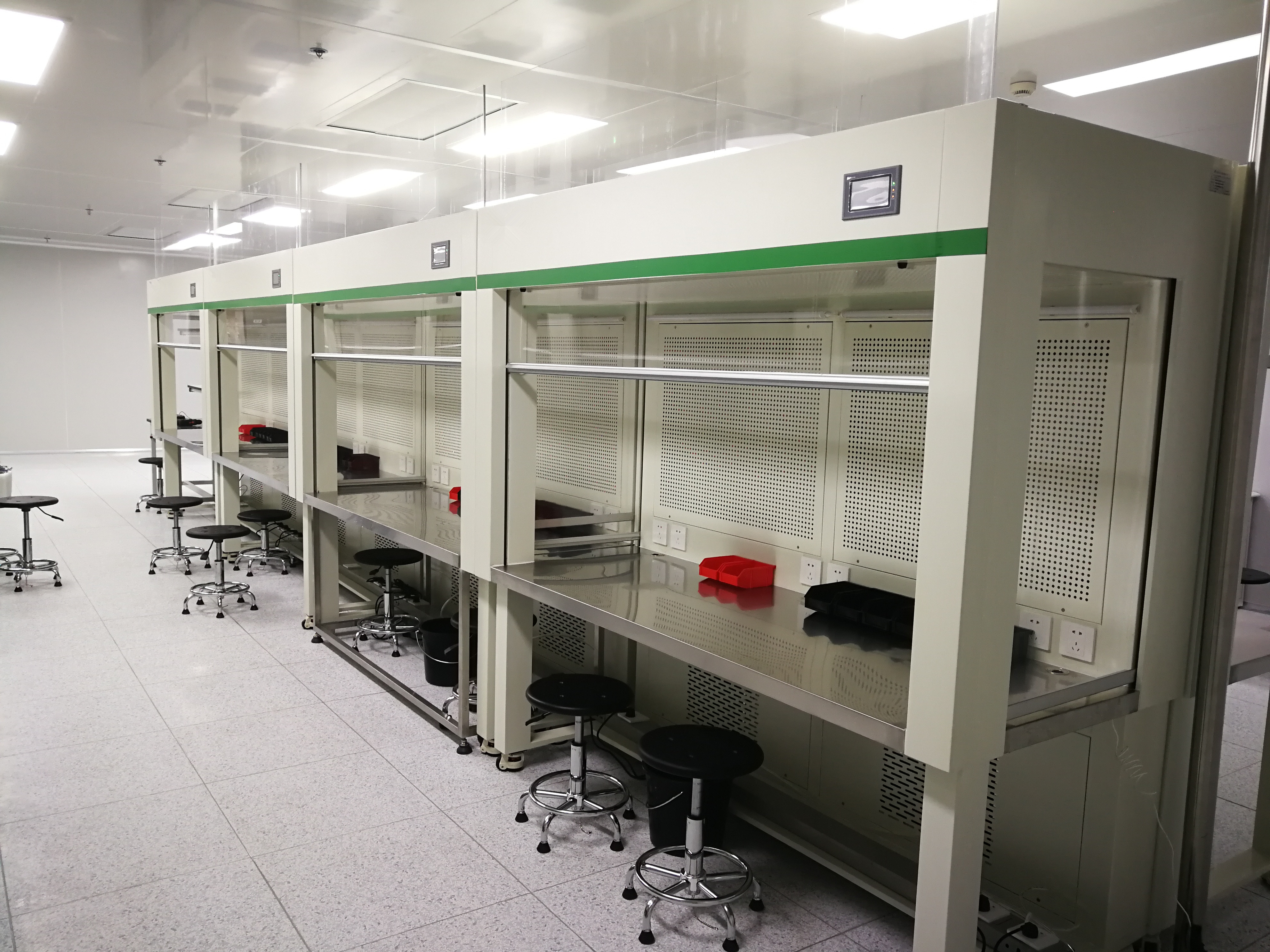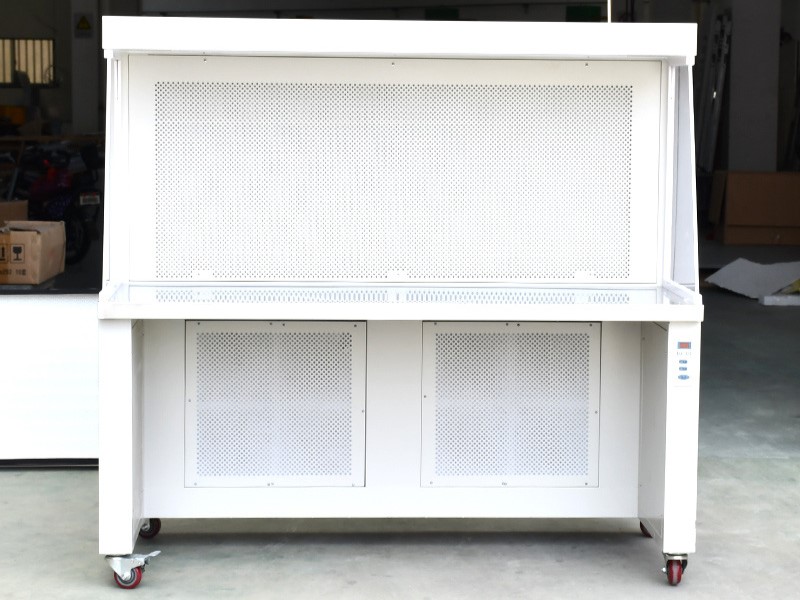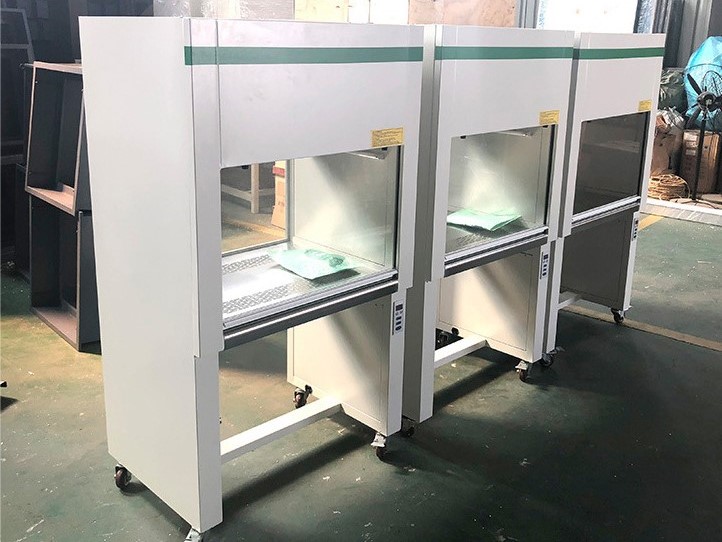Ultra-clean assembly line, also called ultra-clean production line, is actually composed of multiple class 100 laminar flow clean bench. It can also be realized by a frame-type top covered with class 100 laminar flow hoods. It is designed for the cleanliness requirements of local working areas in modern industries such as optoelectronics, biopharmaceuticals, scientific research experiments and other fields. Its working principle is that the air is sucked into prefilter through centrifugal fan, enters hepa filter for filtration through static pressure box, and filtered air is sent out in a vertical or horizontal air flow state, so that the operating area reaches class 100 cleanliness to ensure production accuracy and environmental cleanliness requirements.
Ultra-clean assembly line is divided into vertical flow ultra-clean assembly line (vertical flow clean bench) and horizontal flow ultra-clean assembly line (horizontal flow clean bench) according to the direction of air flow.
Vertical ultra-clean production lines are widely used in areas that require local purification in laboratory, biopharmaceutical, optoelectronic industry, microelectronics, hard disk manufacturing and other fields. The vertical undirectional flow clean bench has the advantages of high cleanliness, can be connected into an assembly production line, low noise, and is movable.
Features of vertical ultra-clean production line
1. The fan adopts a German-origin direct-drive EBM high-efficiency centrifugal fan, which has the characteristics of long life, low noise, maintenance-free, small vibration, and stepless speed adjustment. The working life is up to 30000 hours or more. The fan speed regulation performance is stable, and the air volume can still be guaranteed to remain unchanged under the final resistance of the hepa filter.
2. Use ultra-thin mini pleat hepa filters to minimize the size of the static pressure box, and use stainless steel countertops and glass side baffles to make the entire studio appear spacious and bright.
3. Equipped with a Dwyer pressure gauge to clearly indicate the pressure difference on both sides of the hepa filter and promptly remind you to replace hepa filter.
4. Use an adjustable air supply system to adjust the air velocity, so that air velocity in working area is in an ideal state.
5. The conveniently removable large air volume prefilter can better protect hepa filter and ensure air velocity.
6. Vertical manifold, open desktop, easy to operate.
7. Before leaving the factory, the products are strictly inspected one by one according to the U.S. Federal Standard 209E, and their reliability is extremely high.
8. It is particularly suitable for assembly into ultra-clean production lines. It can be arranged as a single unit according to process requirements, or multiple units can be connected in series to form a class 100 assembly line.
Class 100 positive pressure isolation system
1.1 The ultra-clean production line uses air inlet system, return air system, glove isolation and other devices to prevent external contamination from being brought into class 100 working area. It is required that the positive pressure of the filling and capping area is bigger than that of the bottle washing area. Currently, the setting values of these three areas are as follows: filling and capping area: 12Pa, bottle washing area: 6Pa. Unless absolutely necessary, do not turn off the fan. This may easily cause contamination of the hepa air outlet area and bring about microbial hazards.
1.2 When the frequency conversion fan speed in filling or capping area reaches 100% and still cannot reach the set pressure value, the system will alarm and prompt to replace hepa filter.
1.3 Class 1000 clean room requirements: The positive pressure of the class 1000 filling room is required to be controlled at 15Pa, the positive pressure in control room is controlled at 10Pa, and filling room pressure is higher than control room pressure.
1.4 Maintenance of the primary filter: Replace the primary filter once a month. Class 100 filling system only has primary and hepa filters. Generally, the back of the primary filter is checked every week to see if it is dirty. If it is dirty, it needs to be replaced.
1.5 Installation of hepa filter: The filling of hepa filter is relatively precise. During installation and replacement, be careful not to touch the filter paper with your hands (the filter paper is glass fiber paper, which is easier to break), and pay attention to the protection of sealing strip.
1.6 Leak detection of the hepa filter: Leak detection of the hepa filter is usually performed once every three months. If abnormalities in dust and microorganisms in class 100 space are found, the hepa filter also needs to be tested for leaks. Filters found to be leaking must be replaced. After replacement, they must be tested for leaks again and can only be used after passing the test.
1.7 Replacement of hepa filter: Normally, the hepa filter is replaced every year. After replacing the hepa filter with a new one, it must be re-tested for leaks, and production can only start after passing the test.
1.8 Air duct control: The air in air duct has been filtered through three levels of primary, medium and hepa filter. The primary filter is usually replaced once a month. Check whether the back of the primary filter is dirty every week. If it is dirty, it needs to be replaced. The medium filter is usually replaced once every six months, but it is necessary to check whether the seal is tight every month to prevent air from bypassing the medium filter due to loose sealing and causing damage to the efficiency. Hepa filters are generally replaced once a year. When the filling machine stops filling and cleaning, the air duct fan cannot be completely closed and needs to be operated at low frequency to maintain a certain positive pressure.




Post time: Dec-04-2023

